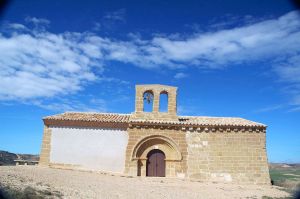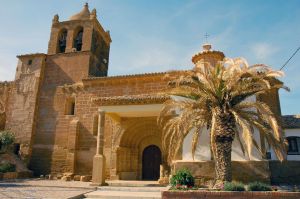The beauty lies in the cleanliness and geometric simplicity of the interior of this 13th century Romanesque church, which is dedicated to Our Lady of the Assumption (Nuestra Señora de la Asunción).
The solidity of the stone structure is a key feature of the building. It has a single nave laid out in four sections that are defined by transverse arches. These drop down onto undecorated capitals that rest on half columns protruding from the walls. The pointed aspect of the vaulted ceiling is a feature of the late Romanesque period. The apse is semicircular on the interior and polygonal on the outside. Its five walls are separated by half columns that finish in smooth capitals with faces at the corners and it is lit by a single window in the centre.
The apse still has a number of Gothic mural paintings that represent scenes of the Passion of Christ although rather unusually, the story has to be followed from the bottom of the wall to the top. The arrival of Christ in Jerusalem on Palm Sunday is shown in one of the lower panels. In the scene of the Last Supper all the people present are sat on one side of the table except for one man who appears in the foreground. The bag he carries identifies him as Judas.
Judas is kissing Jesus in the scene of his betrayal in the Garden of Gethsemane. The soldiers who capture Jesus feature great attention to detail in their chain mail, pikes, shields and tunics. The ugliness of the features of the Jewish people aims to transmit the wickedness of their act. St Peter appears with his sword in hand after having cut off the ear of the Jewish man, Malco.
The predominant colours (blue, white and red), the dominance of the outlines and the distribution of the scenes in panels are all features that reflect the influence of stained glass window art and miniatures as Gothic styles emerged.
The 13th century saw the construction of a new baroque chapel whose dome is lightened by the clever use of decorative plasterwork. The vegetal design of scrolls and garlands reaches every corner and the relief, which is highlighted by light from the oculus, creates dancing shadows that bring an element of fluidity to the area. Wreaths encircle the ovals that feature the images of the four virtues. This same design features in the parish church of Laluenga and the Chapel of San Victorian en the cathedral of Barbastro.
At the west end of the church there was another Romanesque building attached that was once inter-connected; only the crumbling remains of the side wall are still visible. This was an old inn for pilgrims on the Camino de Santiago, dating from the same period as the church and showing similar architectural features. The large room was covered with a pointed vault and its arches rested on capitals decorated with shells. The doorway was dismantled and taken to the church of San Martin in Lérida. A number of medieval paintings that belong to this church and now housed in the Diocesan Museum of Lérida.








